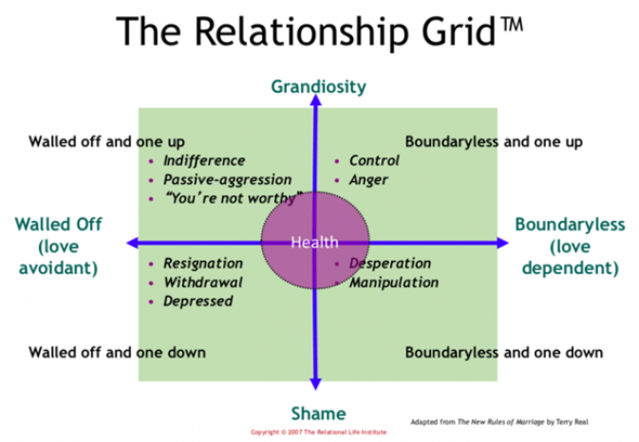What can we expect in our first couples counseling session?
The first time I meet with a couple, there is a lot of ground to cover. Often one partner has never even been to therapy. I tend to start out by asking why you’re seeking therapy. The most frequent answer I get is something like “to work on our communication,” which makes sense but doesn’t help me understand the issue much. In an initial session, I am looking to evaluate the “frame” of the relationship – what is driving the conflict that’s ailing you? In order to provide good treatment, you need an accurate assessment.
I will usually ask how you met, the history of the relationship, and what you do for a living. I’ll seek out information about each of your families, including who was in your household growing up, what your siblings are like (if you have any), and about your parents’ marriage(s). From there, I’ll often introduce couples therapist and author Terry Real’s Relationship Grid, which helps identify characteristic unhealthy behavior patterns in a couple.
On the bottom right are “servants,” or individuals who try to take care of other people to the point of being self-sacrificing. This is your classic codependency. This position is fundamentally unsustainable and often results in people popping up into the quadrant above (see below). Servants can be passive aggressive, bemoaning the ways others do not reciprocate and/or appreciate them. Servants also tend to take things personally, feeling hurt when their partner says he has to work late because they falsely assume he really just doesn’t want to spend time with them. They need to strengthen their egos and challenge such negative thinking patterns.
When people are top right, I call them “fighters.” They are hostile and aggressive. Often fighters have the right message but the wrong delivery, and we need to work on developing assertiveness skills so that you don’t bottle up and explode. Containment can be another important skillset to develop for these individuals, including time outs and other anger management techniques.
Top lefters are “professors,” know-it-alls who believe they do everything the one, right way and that those who do things differently are inferior. Professors can be cruel, robotic, and judgmental. They need to learn how to get off their high horse and have more empathy and tolerance for difference.
Bottom lefters are “turtles,” tucking themselves into their shells to avoid getting hurt. Often depressed and/or anxious, but also sometimes just aloof artist/woodsman types, turtles avoid conflict and often absorb their partner’s vitriol when they should call them out for acting harmfully and inappropriately. Turtles are still human, though, meaning they need connection. Because they don’t know to seek it out from their partner, they often retreat to work, video games, their woodshop, pornography, gambling, or drugs. Turtles need to learn to seek out intimacy in healthy ways and to set limits with partners who transgress theirs.
Once I help patients identify the quadrant(s) they tend to occupy, we have a good sense of the directions in which our work ought to go. Couples tend to leave their first session feeling understood, and better understanding themselves. The goal is not to shame or judge, but to assess and understand so that we can heal and grow.
